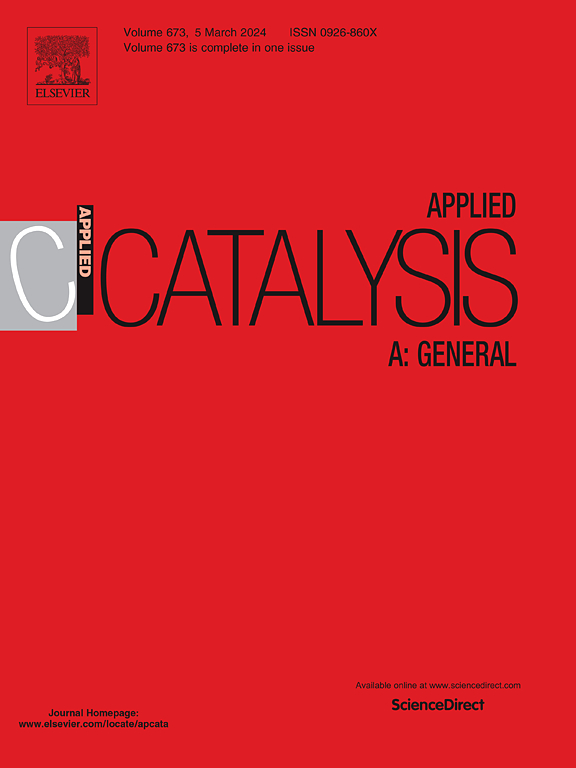基于可再生配体的Cu- mof衍生Cu/C催化剂的高效乙酰丙酸加氢制备γ-戊内酯
IF 4.7
2区 化学
Q2 CHEMISTRY, PHYSICAL
引用次数: 0
摘要
从可再生生物质中合成增值化学品在向可持续和低碳能源系统过渡中变得越来越重要。在此,我们展示了一种溶剂极性调制策略,以2,5-呋喃二羧酸(FDCA)作为可再生配体来设计生物质衍生的Cu-MOF,其中通过Kamlet-Taft参数定制的β/α比平衡成核生长动力学以优化结构特性。在氮气气氛下,在500℃热解Cu- mof生成Cu/C催化剂,该催化剂随后用于乙酰丙酸(LA)选择性加氢制备γ-戊内酯(GVL)。在各种溶剂中,在甲醇和N, N-二甲基甲酰胺(DMF)的混合溶剂中合成的Cu-MOF前驱体表现出最高的催化性能,优于在其他溶剂中合成的Cu-MOF前驱体。这凸显了溶剂选择对Cu-MOF结构的重要影响,从而影响其加氢活性。高级表征证实了均匀的Cu分散(通过HRTEM图证实)和Cu⁰/Cu⁺的电子协同作用(通过Cu俄歇分析)增强了加氢性能。此外,生物质衍生催化剂表现出优异的耐久性。总的来说,这项研究提供了一种利用可再生配体开发高效催化剂的有前途的方法,并展示了通过战略性选择溶剂来调节催化剂性能的潜力,正如Kamlet-Taft参数所示。本文章由计算机程序翻译,如有差异,请以英文原文为准。
Cu-MOF-derived Cu/C catalysts via solvent polarity engineering with renewable ligand for efficient hydrogenation of levulinic acid to γ-valerolactone
The synthesis of value-added chemicals from renewable biomass is becoming increasingly important in the transition to a sustainable and low-carbon energy system. Herein, we demonstrate a solvent-polarity modulation strategy to engineer biomass-derived Cu-MOF using 2,5-furandicarboxylic acid (FDCA) as a renewable ligand, where tailored β/α ratios via Kamlet-Taft parameters balance nucleation-growth kinetics to optimize textural properties. Pyrolyzed Cu-MOF at 500 °C under a nitrogen atmosphere yield the Cu/C catalysts, which were subsequently employed in the selective hydrogenation of levulinic acid (LA) to γ-valerolactone (GVL). Among the various solvents used, the Cu-MOF precursor synthesized in a mixed solvent of methanol and N, N-dimethylformamide (DMF) demonstrated the highest catalytic performance, outperforming those synthesized in other solvents. This highlights the significant impact of solvent selection on the structure of Cu-MOF, which in turn affects their hydrogenation activity. Advanced characterization confirming that the uniform Cu dispersion (confirmed by HRTEM mapping) and Cu⁰/Cu⁺ electronic synergy (via Cu Auger analysis) enhanced hydrogenation performance. Additionally, the biomass-derived catalysts exhibited excellent durability. Overall, this research provides a promising approach to develop highly efficient catalysts using renewable ligands and demonstrates the potential of regulating catalyst properties through the strategic selection of solvents, as informed by Kamlet-Taft parameters.
求助全文
通过发布文献求助,成功后即可免费获取论文全文。
去求助
来源期刊

Applied Catalysis A: General
化学-环境科学
CiteScore
9.00
自引率
5.50%
发文量
415
审稿时长
24 days
期刊介绍:
Applied Catalysis A: General publishes original papers on all aspects of catalysis of basic and practical interest to chemical scientists in both industrial and academic fields, with an emphasis onnew understanding of catalysts and catalytic reactions, new catalytic materials, new techniques, and new processes, especially those that have potential practical implications.
Papers that report results of a thorough study or optimization of systems or processes that are well understood, widely studied, or minor variations of known ones are discouraged. Authors should include statements in a separate section "Justification for Publication" of how the manuscript fits the scope of the journal in the cover letter to the editors. Submissions without such justification will be rejected without review.
 求助内容:
求助内容: 应助结果提醒方式:
应助结果提醒方式:


